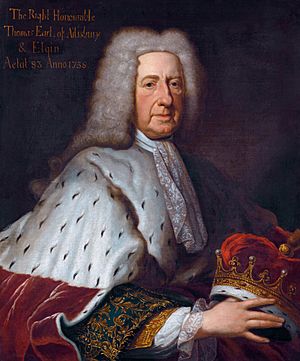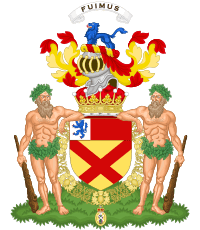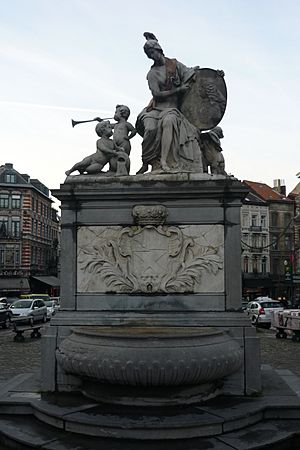Thomas Bruce, 2nd Earl of Ailesbury facts for kids
Quick facts for kids The Earl of Ailesbury |
|
|---|---|
 |
|
| Thomas Bruce, 2nd Earl of Ailesbury and 3rd Earl of Elgin, by François Harrewijn, 1738 | |
| Spouse(s) | Lady Elizabeth Seymour Charlotte d'Argenteau |
| Issue | |
| Robert Bruce, Lord Bruce Charles Bruce, 4th Earl of Elgin Elizabeth Brudenell, Countess of Cardigan Marie, Princess of Hornes |
|
| Father | Robert Bruce, 2nd Earl of Elgin |
| Mother | Lady Diana Grey |
| Born | 1656 |
| Died | 16 December 1741 |
Thomas Bruce, 2nd Earl of Ailesbury (born in 1656, died in 1741) was an important English politician and writer. He was also known as the 3rd Earl of Elgin. From 1663 to 1685, people called him Lord Bruce.
Thomas Bruce was the son of Robert Bruce, 2nd Earl of Elgin, and Lady Diana Grey. His Memoirs, which are like his personal diary and memories, were published long after he died. These writings are very helpful for understanding English history in the late 1600s.
Contents
Early Life and Political Career
Thomas Bruce started his career in politics at a young age. He was elected as a member of parliament for Marlborough from 1679 to 1681. Later, in 1685, he represented Wiltshire in parliament.
In 1676, he became a Gentleman of the Bedchamber. This was an important role, meaning he was a close attendant to the King. When he inherited his earldom in 1685, he became a Lord of the Bedchamber. He also served as Lord Lieutenant of Bedfordshire and Huntingdonshire.
Thomas Bruce was a Page of Honour at the coronation of King James II in 1685. He was very loyal to King Charles II. Charles II even said on his deathbed, "I see you love me dying as well as living." Thomas Bruce was sad when Charles II died, writing that his "happy days at a Court" ended then. He also admired King James II, even though he saw some of his flaws as a ruler.
Thomas Bruce's Family
Thomas Bruce married his first wife, Lady Elizabeth Seymour, on August 31, 1676. She was the daughter of Henry Seymour, Lord Beauchamp. Lady Elizabeth died in 1697. They had three children together:
- Robert Bruce, Lord Bruce (1679–1685)
- Charles Bruce, 4th Earl of Elgin (1682–1747)
- Lady Elizabeth Bruce (1689–1745), who married George Brudenell, 3rd Earl of Cardigan.
He married his second wife, Charlotte d'Argenteau, in Brussels on April 27, 1700. They had one daughter:
- Lady Marie Thérèse Bruce (1704–1736), who married Prince Maximilian Emmanuel of Hornes.
Life in Exile
Thomas Bruce was one of only four noblemen who continued to support King James II after Prince William of Orange arrived in England. In 1688, he went with King James to Rochester when the King left London. Thomas Bruce decided to stay in England for a while. He was willing to support the new government, but people always wondered if he was truly loyal.
In May 1695, Thomas Bruce was accused of planning to bring King James II back to power. In February 1696, he was put in the Tower of London. However, he was allowed to leave a year later and went to Brussels. He lived in Brussels for over 40 years as an exile. He died there in 1741 and was buried in Brussels.
Some historians believe he was not completely honest. They say he swore loyalty to King William III while secretly planning to bring back King James. Others argue that he was loyal to the idea of the monarchy itself. They think he supported the ruler he believed was best at the time. King William III did not seem to see him as a big threat, which is why he was left alone after he left England. Thomas Bruce was lucky to have many friends and few enemies. It seems he could have returned to England around 1710. But he was happy living in Brussels with his second wife, Charlotte, and he had no real reason to go back home.
His Good Character
Thomas Bruce was liked by almost everyone, even those who disagreed with him politically. He was known for being honest, decent, and fair. King Charles II clearly liked him and trusted him a lot. King James II also liked him. Even King Louis XIV of France thought he was one of the few British noblemen who wasn't just interested in himself.
Even though Thomas Bruce changed his own loyalties, he did not like people who switched sides just for their own benefit. He disliked Sunderland and told his cousin Danby that he deserved to be punished for betraying King James II.
His Famous Memoirs
Thomas Bruce spent many years writing his Memoirs. These detailed writings were not published until 1890. Historians have praised them highly. They are especially valued for their clear descriptions of important people in British life. These include King James II, King William III, Danby, Sunderland, Lauderdale, and Halifax.
Perhaps the most striking part of his memoirs is how much he admired King Charles II. He called him "my good and gracious master, the best that ever reigned over us."




